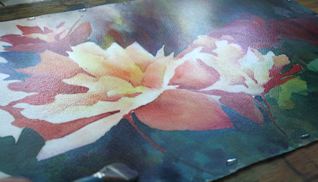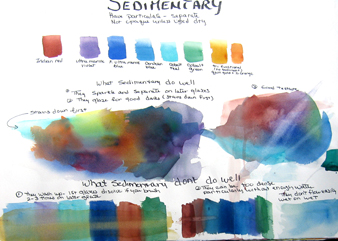
The painting of begonias that I’d started at the end of summer last year was almost finished. I had decided I wanted another dark on the right side and cast a second shadow on the wall. I wanted a little more interest in the darks above the flowers and also below.
It happened that it was also time to stretch it for framing so I soaked it (see Technique Corner, 6/09 for that process) and stapled it to a plywood board.
While it was still wet — note the shine on the paper:

That is the secret of “floating.”
Here I have a mix of green gold and ultramarine blue on my brush and let it flow onto the wet paper.

You don’t brush back and forth but let the water on the paper suck the water and color out of the brush. If it goes too far, you can use a dampened tissue (not paper towel) to wick the color away.
In the same way, I floated some cobalt green across the strong yellow area on the bottom and, with a pointed brush, did a bit more tracery in the darm blue area.
Before:

and after:

So when do you “float” color onto your painting?
When you wish to change an area that is more or less resolved but needs some fine tuning
When you want to shift an area — quiet a number of background shapes down, unify some shapes that are jumping around too mucj
When painting another layer of paint on dry paper is going to make the area too dull or dense.
Do you have to soak the whole paper any time you float paint?
No you don’t. You can wet a small area and float color in – for example a shadow area over the skin tones you have painted, or adjusting the color in fruit, a china cup, etc.
How is this different from wet-on-wet?
The way you handle your brush — wicking the color out of the brush instead of brushing across the paper
What kind of pigments do you use?
Good question! This is the time to use sedimentary colors (Technique Corner 10/10):

They separate as they float onto the paper and allow the undercolors to show through.
This only happens if they are wet enough to separate.
If you put them on dry, they act like the clay they are or partly are and appear as an opaque mask.
Some of the clearer dye colors also may be floated on such as the green gold, the quinacridones, aurolean yellow and perinone orange.
And I will remind you to look at Do You Know Your Basics? If you want a hands-on session on basic processes, my once-a-year class on the basic techniques of watercolor is coming up again this May. See Class listings.
Enjoy floating your colors.
Caroline
© Caroline Buchanan, 2015
